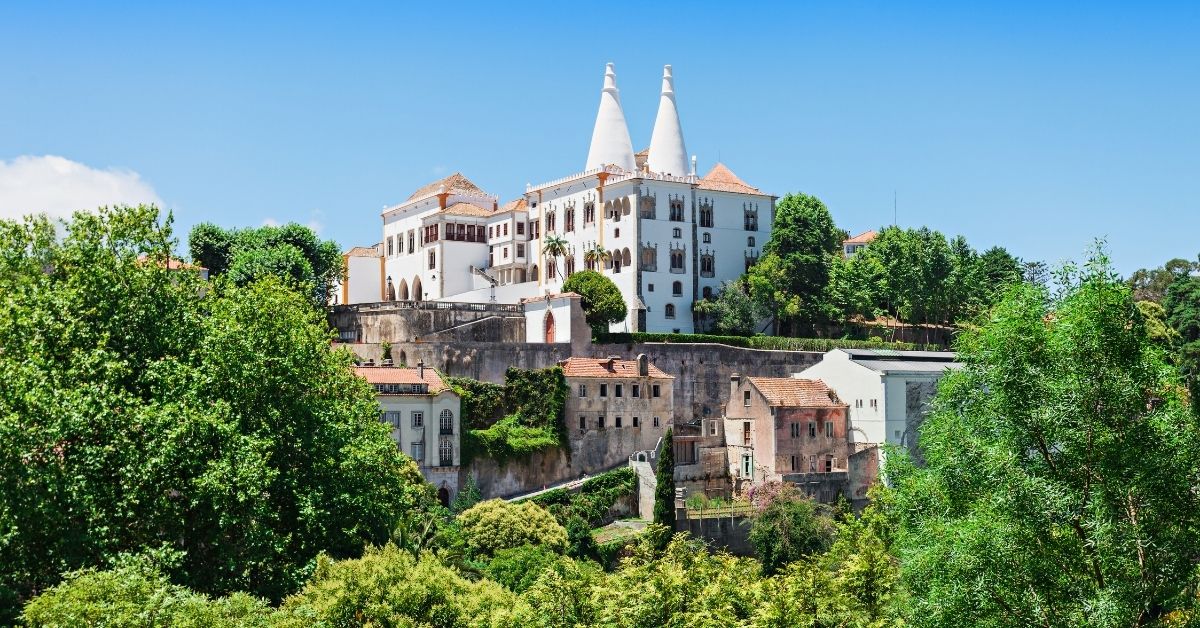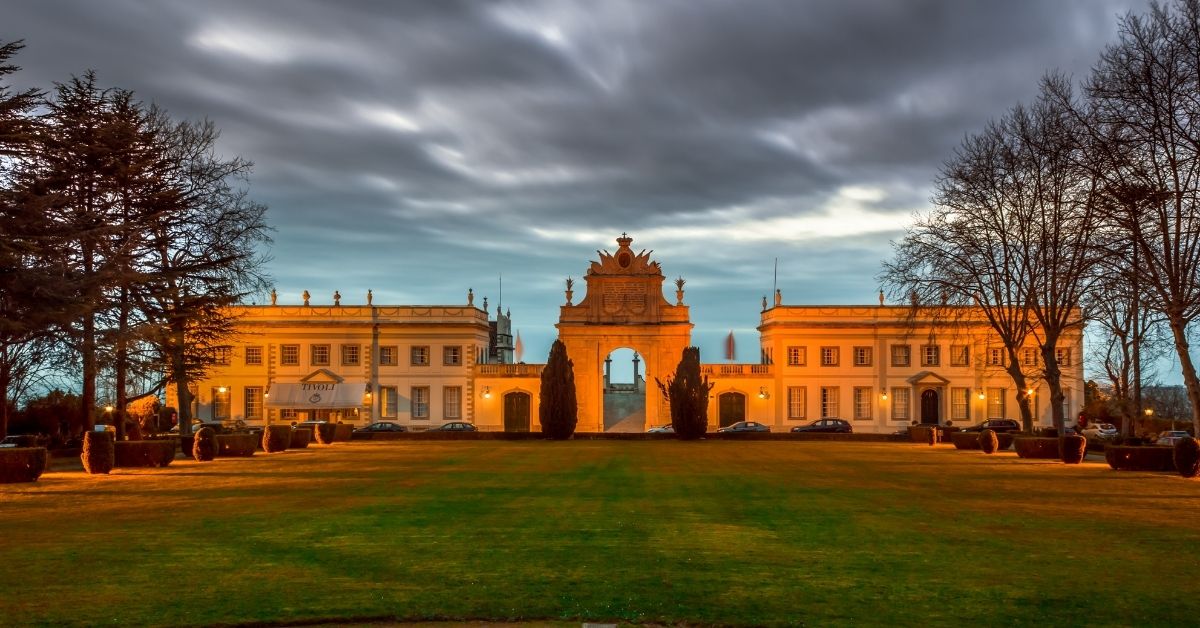Located amid the pine-covered hills of the Serra de Sintra, the charming town of Sintra is a historically and culturally important site that has been awarded UNESCO World Heritage status.
Surrounded by beautiful beaches and impressive views of the Atlantic coast, its main attractions are its stunning castles and palaces, built in various architectural styles and ranging from the majestic to the whimsical.
Ready To Travel? Don't Go Without Travel Insurance.
I recommend SafetyWing Nomad Insurance, an affordable travel insurance offering automatic monthly payments that you can cancel anytime. I've been using it since 2019, and I can assure you it's the perfect solution for nomads like you and me. Learn more by reading our SafetyWing review.There are more of these historic buildings than you can comfortably see in one day – so this list of the most beautiful castles in Sintra, Portugal, is designed to help you choose the ones you wish to visit most.
Pena Palace (Palácio Da Pena)
The most recognizable and popular of all the castles in Sintra, the enchanting Pena Palace boasts a stunning mountaintop location.
It is a beautiful example of the Romanticism style of architecture, with decorative battlements and brightly colored terraces. Romantic design features even extend into the surrounding Parque de Pena Forest, a highlight of the visit for many.
Covering more than 200 hectares, this verdant forest is filled with hidden pathways, secret tunnels, and mystical statues.
The most stunning parts of the castle include the vividly painted Queen’s Terrace – from which you can enjoy jaw-dropping views across Sintra – and the fearsome gargoyle guarding the palace entrance.
The interior of Pena Palace is every bit as captivating as the exterior, and you can visit the majestic staterooms decorated with stucco art that once served as the summer residence for the royal family.
If you get a chance, pay a visit to the 259 m high Cruz Alta viewpoint, from where you can get the very best views of the entire castle, along with panoramic vistas of its beautiful surroundings.
In fact, there are plenty of opportunities for hiking in Sintra if you have enough time.
Quinta Da Regaleira
The captivating Quinta da Regaleira is the most intriguing of the Sintra castles. It was bought in 1892 by a very mysterious, eccentric millionaire by the name of Antonio Monteiro.
Believed to be a Free Mason, Monteiro was a superstitious man, fascinated with Hermeticism, a blend of ancient Egyptian religion, magic, science, and philosophy.
It was this interest that led him to spend the next 20 years renovating the castle and filling it with mysterious images and symbols that reflected his beliefs. The result is an eerie, fairy-tale-like estate that is both creepy and fascinating!
The building itself covers five floors, although after entering via the grand archway you can only explore the first floor. Here you will see stunning fireplaces, beautiful wooden ceilings, and inlaid mosaic floors.
The exterior of the castle is a mixture of various architectural styles, including Gothic, Moorish, and Renaissance, with plenty of turrets and gargoyles!
But the main attraction of Quinta da Regaleira is the fabulous gardens, with miniatures lakes and romantic secret grottoes, along with the Promenade of the Gods, lined with statues of Greeks gods and goddesses.
The highlight is the enchanting Initiation Well that was reportedly used in mystical ceremonies, down which you can walk 9 floors underground to the secret tunnel at its base.
Staying In Sintra?
Make sure to book a stay in one of the best hotels in Sintra.
Best hostel: Casa Azul Hostel
Best mid-range hotel: Sintra Boutique Hotel
Best luxury hotel: Tivoli Palacio de Seteais
Glamping: Glamping Sintra
Castle Of The Moors (Castelo Dos Mouros)
Unlike all the other castles in Sintra, the Castle of the Moors lies in ruins. Nevertheless, these are spectacular ruins that are definitely worth a visit, snaking their way over the hills in a manner reminiscent of the Great Wall of China.
The castle was originally built as a fortification by the Muslim Moors in the 8th-9th century because its strategic position at the top of one of the highest hills in the area meant that it had excellent views right across the region.
It is those views that make this one of the most popular Sintra castles to this day and you can enjoy them as you walk along its crumbling walls.
But there is more to see when you visit, including ancient towers to climb and battlements to explore, plus the ‘Second Ring of Walls’. This served as an extra fortification to protect all the people and livestock who lived in the castle surroundings.
You can even see some of the silos that were used by the people for storing cereal and legumes.
Monserrate Palace (Palácio Da Monserrate)
Because of its location somewhat further outside of the town center than other castles in Sintra, the Monserrate Palace receives fewer visitors and is one of the most peaceful.
Originally built by an English merchant, it was later acquired by another Englishman who went on to commission much of the architecture, which is a unique and fascinating blend of several styles.
When you look at the castle from the outside you can see the perfect symmetry which is typical of Islamic architecture, but then the stone arches are gothic in their design.
You can also see influences of Indian and Arabian design – indeed, the castle feels as if it should be in Morocco! – yet its beautiful and immaculate gardens are classically English in style.
The interior is incredibly striking, with a gallery running the length of the palace featuring geometric latticework supported by rose marble columns. You can also see gorgeous stone carvings in the music room, the library, the main hallway, and the atrium.
As you walk from the palace to the gardens you cross the first lawn ever laid in Portugal and come to the botanical gardens.
With over 1000 species, the gardens – dotted with ornamental lakes and shaded, tranquil walkways – pre-date the 1860 construction of the villa itself.
Sintra National Palace (Palacio Nacional De Sintra)
Unlike most of the palaces in Sintra that have extensive gardens to explore in addition to their fabulous interiors, the main attractions of the National Palace are indoor. If you are unsure which castles to visit in Sintra on a rainy day, this one would be ideal!
What’s more, it is in the heart of the historic town center, so it is very easy to get to. The best-preserved medieval residence in Portugal, the palace was home to the country’s ruling nobility from the 15th to the 19th centuries.
The building that we see today – with its central courtyard and whitewashed facades – was constructed by Dom João I in the 15th century. It is famous for its iconic 33m high white chimneys, which look like enormous inverted ice cream cones.
These chimneys lead from the kitchens and were designed to take the heat from the massive ovens and fires away from the main chambers of the palace.
There are some lovely rooms to visit inside, named after their peculiar characteristics (a Swan Room, for example, decorated with swans and the bird-filled Magpie room).
Seteais Palace (Tivoli Palacio De Seteais)
Seteais Palace is a little different from other palaces in Sintra – it is now one of the region’s most luxurious hotels!
Although that gives you the option to spend a night in a real palace, you don’t have to be staying there in order to see it and visitors are welcome to view the rooms decorated with beautiful frescoes.
Built between 1783 and 1787, this striking neoclassical building is located right on the edge of the Serra de Sintra, giving you lovely views of both the town and the surrounding countryside.
It is worth a visit just to take a walk through the extensive gardens that are filled with features inspired by the Romantic movement, along with an abundance of fruit trees.
How To Get To Sintra From Lisbon
Sintra is only 30 km / 19 miles from Lisbon, and traveling between the two is easy.
By Train
Direct trains run from Rossio Station in Baixa, Lisbon to Sintra at least four times an hour, with the journey taking just 40 minutes. You need to pay for your trip using a Viva Viagem card.
This card is used for all public transport in Lisbon and can be bought from the ticket office or automatic ticket machines at the station. You can’t buy your tickets online.
The station in Sintra is just a 10-minute walk from the town center, but if you plan on visiting the Moorish Castle – which is located on a steep hill 5 km outside town – you might want to take the number 434 bus.
By Car
The IC19 motorway runs between Lisbon and Sintra. At quiet times the journey takes around 30 minutes, but be prepared for it to take quite a bit longer at peak times, as it is a busy commuter route.
Do be aware that parking can be a challenge, although there is one main car park in town and you can then take taxis from there to see the various sights.
Didn’t rent a car yet? Browse your options here.
By Bus
Because the train to Sintra is so inexpensive and convenient, it is a far more popular option than the bus.
However, if you would prefer to take the bus, then you would need the Sintra Express which runs from the bottom of Parque Eduardo. The journey takes 30 minutes and you can buy a round-trip ticket that allows you to board the 434 tourist bus whilst in Sintra.
You will also find many tour operators in Lisbon offering day trips to Sintra. GetYourGuide offers a private tour from Lisbon or Cascais – you can learn more here.
Final Thoughts On The Best Castles In Sintra
I hope that this guide to the most beautiful castles in Sintra, Portugal, has helped you decide on the places you’d most like to visit.
If you only have one day in Sintra, your best option would be to follow the route of the 434 bus. This will take in the Sintra National Palace, the Castle of the Moors, and Pena Palace, which most visitors agree is the absolute highlight of the trip and not to be missed!
Make sure to read our 10-day itinerary in Portugal if you’re still planning your holidays.








